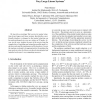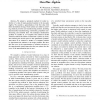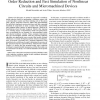AUTOMATICA
1999
15 years 8 days ago
1999
This paper considers the problem of balanced model reduction for a class of distributed parameter systems. The system is assumed to have a finite-dimensional state vector as well ...
92
Voted
CCE
2004
15 years 13 days ago
2004
Bifurcation theory provides a powerful tool for analyzing the nonlinear dynamic behavior of process systems. However, although the theory in principle applies to lumped as well as...
AUTOMATICA
2005
15 years 15 days ago
2005
This note furthers existing results on the model reduction of stable periodic systems. It utilizes for that matter a lifting technique to potentially attain less conservative erro...
123
Voted
FAC
2008
15 years 19 days ago
2008
Abstract. Slicing is a program analysis technique that was originally introduced to improve program debugging and understanding. The purpose of a slicing algorithm is to remove the...
125
Voted
CMSB
2008
Springer
15 years 2 months ago
2008
Springer
Kinetic models for biochemical systems often comprise a large amount of coupled differential equations with species concentrations varying on different time scales. In this paper w...
80
Voted
CDC
2009
IEEE
15 years 5 months ago
2009
IEEE
— In general, existing model reduction techniques for stable nonlinear systems lack a guarantee on stability of the reduced-order model, as well as an error bound. In this paper,...
IPPS
2003
IEEE
15 years 5 months ago
2003
IEEE
We describe a prototype Web service for model reduction of very large-scale linear systems. Specifically, a userfriendly interface is designed so that model reduction can be easi...
126
click to vote
LSSC
2007
Springer
15 years 6 months ago
2007
Springer
Model reduction of large-scale linear time-invariant systems is an ubiquitous task in control and simulation of complex dynamical processes. We discuss how LQG balanced truncation ...
85
Voted
CDC
2008
IEEE
15 years 7 months ago
2008
IEEE
Abstract— We present a systematic method for model reduction of a class of input-quantized systems in the max-plus algebra. We consider a generalization of the flow shop with �...
113
click to vote
ICCAD
2001
IEEE
15 years 9 months ago
2001
IEEE
—In this paper, we present an approach to nonlinear model reduction based on representing a nonlinear system with a piecewise-linear system and then reducing each of the pieces w...



